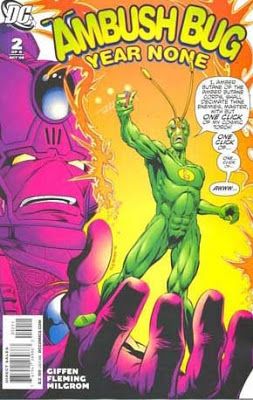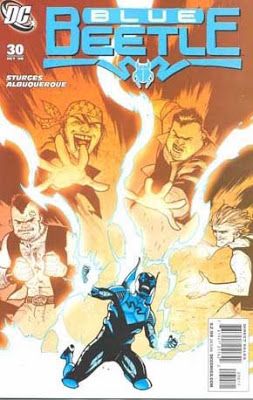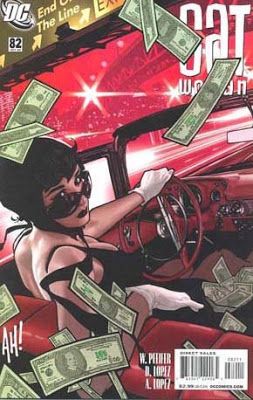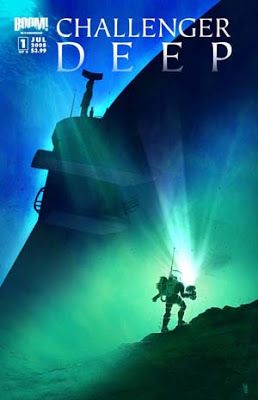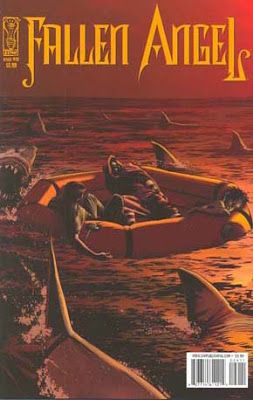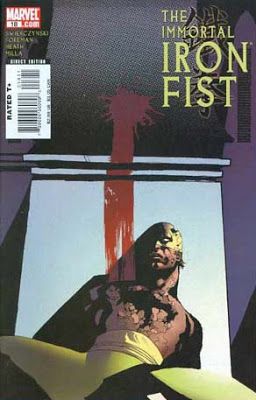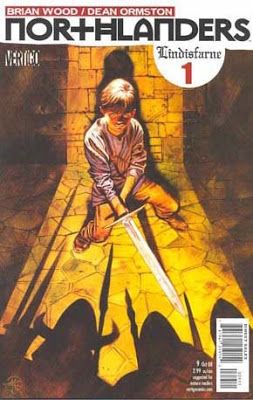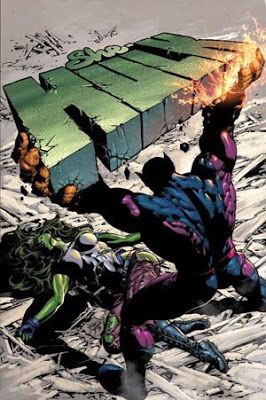There were a bunch of decent comics this week, but only one was really dazzling. Does that mean I have to dump a bunch of books? Not really. I like good solid comics, after all. And that's what we got this week - it's the comfort food meal of comics!
Ambush Bug: Year None #2 (of 6) by Keith Giffen (plotter/penciller), Robert Loren Fleming (scripter), Al Milgrom (inker), Pat Brosseau (letterer), and Guy Major (colorist). $2.99, 22 pgs, FC, DC.
I honestly have very little idea what the heck is going on in this comic. I just know I laughed quite a bit. Its title is "Five Million Elvis Impersonators Can't Be Wrong!", after all, even though there are no Elvis impersonators actually in the comic. It lurches from page to page, not ever making much sense, but, as with most Ambush Bug comics, Giffen and Fleming simply try to cram as much goofy stuff into 22 pages as they can. And just like last issue, when we learned what really was behind Sue Dibny's murder, in this issue we find out why exactly Ted Kord died. Plus, we learn what Batman's OMAC satellite was really doing. Giffen and Fleming make sense of the DCU when no one else can!
Many laughs. Little sense. Isn't that why we all fell in love with comics in the first place?
Blue Beetle #30 by Matthew Sturges (writer), Rafael Albuquerque (artist), Steve Wands (letterer), and Guy Major (colorist). $2.99, 22 pgs, FC, DC.
Sturges seems to have a good handle on Jaime and his gang and what makes this book so keen, and Albuquerque's art, naturally, helps smooth over any rough patches. This is a solid issue, with Jaime trying to find out more about the superpowered dudes he fought last issue, and Sturges does a good job with this, as he visits La Dama and that weird bunch from earlier in the series (whose names escape me). There's also a nice scene, reminiscent of the very best olde-skool Amazing Spider-Man, of Jaime and his friends at the superhero mini-golf course, where there's chick jealousy, mistaken identity, and Jaime trying to hide a change into Blue Beetle (plus, one of the holes on the course has Vigilante, which is pretty neat). Even outside of this scene, Sturges adds some fun touches, like when one of the options the armor gives Jaime about how to deal with the bad guys is "Implicate-order annihilation field," which may be "fatal" and also have "potential theological implications." It's little stuff like this that makes the book fun, but Sturges also gives us a tense fight and ending that takes the book into some slightly darker territory. As always, it's good stuff.
Seriously: if you liked Amazing Spider-Man back when it was good, don't read Spider-Man now, read Blue Beetle. It has everything you always loved about that title, without politicians getting shot in the head!
Catwoman #82 by Will Pfeifer (writer), David López (penciller), Álvaro López (inker), Jeromy Cox (colorist), and Jared K. Fletcher (letterer). $2.99, 22 pgs, FC, DC.
As an ending of a series, this is bound to be disappointing, because DC is not going to kill Selina nor let her ride off into the sunset like Jack Knight did. She has to remain Catwoman and she has to remain in Gotham City, so the fact that her series is ending doesn't mean there are any changes to the status quo. Pfeifer does what he can, and it's not a bad issue, mainly because the "chat" that Selina has with Bruce is almost perfect, but it all comes down to Selina wanting to be Catwoman, which, based on how her life has gone recently, feels awkward but is necessary. I'm a bit disappointed DC didn't let Selina walk away for a while, at least, to give this series a bit of closure (I'm assuming Pfeifer would have written a different ending if he could have, because whether DC told him or not, he knows she's integral to Batman's mythos, so anything too radical would be retconned eventually). They could always bring her back later, but it would have made this run a bit more consequential.
That's not to say this hasn't been a wonderful comic to read. When I first picked it up, it was mostly because of Pete Woods' art. Prior to One Year Later, Pfeifer wrote some decent stories but seemed to have some problems finding his footing. The stories weren't bad enough to make me drop the comic, but I kept waiting for that one lousy issue that would give me an excuse to do so. When López came on and Pfeifer jumped ahead a year, the book really took off (not to say that Woods' art wasn't great, because it was, but López coming on board coincided with Pfeifer getting better, even though I doubt there's a connection). It's been one of DC's best books for over two years, and it's a shame the sales didn't reflect that more. But all good things must come to an end, and at least I can re-read these issues.
I would like to point out that López pencilled something like 30 straight issues of this comic (I can't remember exactly which issue was his first). That's on a monthly comic, by the way. His art is not flashy like many artists working today, but it's extremely good, and in many issues it was truly wonderful. That someone like López can keep up with a monthly grind puts a lot of other artists to shame. I hope he gets a higher-profile book next, because he deserves it.
If you came on board this book too late to save it, the trades are out and very good. Then you'll be just as sorry as me that it's gone!
Challenger Deep #1 (of 4) by Andrew Cosby (story), Andy Schmidt (story/scripter), Chee (artist), Andrew Dalhouse (colorist), and Marshall Dillon (letterer). $3.99, 22 pgs, FC, Boom! Studios.
With Boom! Studios, you either get horror comics that I have no interest in or video game adaptations that I have no interest in (sorry, Chip!) or books that have a really cool hook. Guess which one this is? This comic begins with an American nuclear submarine somehow crashing near the Marianas Trench. If that's not bad enough, the sub is on a shelf of methane ice. Methane ice, a character helpfully explains, is methane that was subjected to such pressure that it solidified into ice. Unfortunately, that makes it combustible. And if a sub is lost, its warheads detonate after 72 hours (in order to make sure terrorists haven't taken the sub and are planning to use it for nefarious deeds). Exploding warheads + highly combustible methane ice = Armageddon (yes, Armageddon - trust me!). Damn, that sucks.
So the government calls in the man - Eric Chase - who discovered terrestrial methane ice, but there are, naturally, problems. He was once the best oceanographer, but when his wife was lost at sea, he abandoned his career. So, of course, they have to convince him to come back. They do this by mentioning the name of someone on the sub. We don't know who this person is, but Dr. Chase does, and that convinces him to help.
Like several solid Boom! books, the high concept carries this a long way, as the execution is a bit cliché-heavy (brilliant man experiences tragedy, forsakes chosen way of life, and then is convinced to return to save the world). It's all in the execution, of course, and Schmidt is a solid storyteller, and Chee's art is decent. There is one thing that adds a bit of mystery to the proceedings - early in the book, the sub's captain seems to think that the sub is being tracked by something, and he seems unconcerned. It's an odd little scene, and indicates that there's more going on here than just a crashed submarine. We'll see where Cosby and Schmidt are going with it.
As usual with comics from Boom!, there's a lot to like about the first issue. Also as usual, there's a lot that's familiar. But they have a good track record of making these comics a nice, exciting read, so I'm looking forward to the rest of the series.
Fallen Angel #29 by Peter David (writer), J. K. Woodward (artist/colorist), and Robbie Robbins (letterer). $3.99, 22 pgs, FC, IDW.
Peter David is a great comic book writer because he doesn't let you get comfortable at all. You're always on your toes, waiting to see what crazy thing is going to happen next. I'm not talking about the squid that suddenly attacks our heroes as they head across the Pacific toward the City of Life, although that's a fun scene. I'm talking about Mickey, the man who isn't affected by Mariah's touch at the beginning of the issue. Mariah's touch burns everyone, so those who aren't burned are somehow special. We think this means Mickey will play a greater role in the proceedings as we move along, but ... he doesn't. The way David sets this whole thing up and then pulls the rug out from under us is why he's a great writer. He never lets us forget the randomness of life. Shit happens, indeed, and not everything is a sign of bigger things. Occasionally the way David makes this point doesn't sit well with me (the random slaughter of the campers in She-Hulk is a recent example), but that's part of the point - you really never know what's going to happen in a Peter David comic. And that's a good thing.
Oh, and the Comic-Con has a cameo in this issue. It's cute.
The Immortal Iron Fist #18 by Duane Swierczynski (writer), Travel Foreman (artist), Russ Heath (artist), Matt Milla (colorist), and Dave Lanphear and "Natalie" (letterers). $2.99, 22 pgs, FC, Marvel.
I'm still not completely sold on the new team on Iron Fist, but this issue was better than #17, so I'm willing to give Swierczynski and Foreman some time to figure out what they're doing. It doesn't hurt that this is basically an extended fight scene, as Danny fights that dude who kills Iron Fists and then calls in Luke Cage, Misty Knight, and Colleen Wing to take a few pokes at him. Danny escapes, of course, and we get to learn a little about why this dude wants to kill the Iron Fists and that he has some help inside Rand's business. Oh dear. If it's not quite as good as when Brubaker and Fraction were writing it, Swierczynski still brings in some nice touches, like Orson Randall's heroin usage helping him escape his fate. I never like when something bad is happening and it's fairly obvious, but the characters don't recognize it. Yes, Danny has been through a traumatic event, but when a dude comes to him with "financial irregularities," he really ought to listen. It seems like superheroes, who ought to know better that EVERYTHING is connected (much more so than in real life), would pay more attention when characters we've never seen before show up with weird things happening.
Foreman still has some weird layout problems, but when he's not doing fight scenes, he's fine. There are a couple of very strange panels, however - exactly what is going on in the first panel on page 7? I don't mind the highly stylized elongated limbs that Foreman gives the characters - comics shouldn't necessarily be "realistic," after all, and this is definitely not that - but I do want to be able to understand what's going on, and occasionally Foreman falls short in that department. It's not bad, but it's taking me a bit to warm up to it.
Two more issues of this story arc should give me enough information to decide if I want to keep buying it. The arc isn't blowing me away, but it improved over last issue, so that's something.
Marvel Comics Presents #12. "Vanguard" by Marc Guggenheim (writer), Francis Tsai (artist), Tony Washington (colorist), and Dave Sharpe (letterer); "Machine Man" by Ivan Brandon (writer), Niko Henrichon (artist), and Dave Sharpe (letterer); "Man-Thing" by Jai Nitz (writer), Ben Stenbeck (artist), and Dave Sharpe (letterer); "Weapon Omega" by Rich Koslowski (writer), Marco Checchetto (artist), Laura Villari (colorist), and Dave Sharpe (letterer). $3.99, 32 pgs, FC, Marvel.
As a "final" issue (as I've mentioned, Marvel is apparently rebooting this, so there's no #13 for now, and I suppose this might be relaunched with a #1 issue), we get the conclusions of three story arcs, which is nice. "Vanguard" doesn't finish as strongly as it's been, mainly because Guggenheim sets it up as a continuing story, and who knows if we'll ever see more of it. "Weapon Omega" also ends as if Koslowski is setting up a continuing story, but it ends more satisfactorily. Brandon and Henrichon's Machine Man tale, however, just kept getting better after a shaky first chapter. It's a short story (40 pages), but it would be nice if Marvel collected it. In the final chapter, we learn all the secrets of Aaron Stack, and Brandon makes a very funny Wolverine joke. And the Man-Thing story is pretty neat, too.
MCP didn't succeed, but it's still a good idea. If only Marvel would lower the price. As usual, I don't understand the economics involved, but I think this book would have done better with a $1.99 price tag on it. Or even $2.50. But what the hell do I know?
Northlanders #9 by Brian Wood (writer), Dean Ormston (artist/colorist), and Travis Lanham (letterer). $2.99, 22 pgs, FC, DC/Vertigo.
Well, holy crap, it's a different artist on Northlanders and a completely different time period (200 years before the first arc), but who cares? It's still a winner. This arc takes place at Lindisfarne, the abbey on the northeastern coast of England that was sacked by Vikings in AD 793, an event that announced the presence of Northmen to the world. Wood tells the story using a young boy, Edwin, as the narrator. Edwin lives with his father and brother near Lindisfarne, and he hates it. He pines for his dead mother, whom he naturally believes was a wonderful true pagan, whereas his father is evil and therefore all Christians are. He wishes for pagan gods to cleanse the land, and lo and behold - the Vikings show up. Edwin says he'll lead the Vikings to the monastery because they're in England to "save" him, and of course the Vikings take him up on that. Oh dear. Something bad is going to happen next issue, I'm sure.
Ormston's art is fantastic, with the double-paged spread of the Viking ships arriving the highlight of the comic. Like Gianfelice before him, Ormston does an excellent job showing how bleak the landscape of northern Europe was during the early medieval period (I refuse to call them the "Dark Ages," which is an almost complete misnomer). Nature is a huge presence in this world, and therefore it's not surprising that Edwin calls upon the forces of nature to help him (giving us another magnificent drawing of a god rising out of the surf). It's a beautiful comic.
As usual, I have some historical questions, and I know Wood occasionally stops by, so I'd love it if he could address them. Edwin's brother is named Cerdic, after the sixth-century Saxon king of Wessex. Wood writes, "My father, eager to please his German wife, named him so." I don't really have a problem with that, but I do wonder if a normal man (not a scholar) living in northern England with a German woman in the late eighth century would know anything about a king from over 200 years earlier who is first mentioned in history by the Anglo-Saxon Chronicle a century after the events of this book. The fact that Edwin is named after a king of Northumbria who died only 150 years earlier and was venerated as a saint for converting to Christianity is a bit more believable. Wood uses this to set up the dichotomy between Edwin's pagan beliefs (as he's named after a Christian) and Cerdic's (presumably) Christian beliefs. Edwin, however, tells us that his mother died in childbirth. His father got drunk and then fell in with the monks and emerged a Christian. So Edwin has lived his entire life among the monks. My question is: Where did he pick up these pagan beliefs? Where did he even learn about a different god then the Christian one? It's implied (though not necessarily confirmed) that he never goes out and about, and Lindisfarne, anyway, wasn't near an urban center (and still isn't). The only exposure to religion he has is Christian. He might hate the Christians, but how does he have any alternative? It feels a bit like Wood channeling some of his own objections to Christianity, because Edwin seems far too sophisticated for his objections. As usual when I start thinking about motives of the writers, I have no idea what Wood thinks of Christianity, so I'm not going to go as far as to say these are his thoughts completely (he might be a devout Christian for all I know, and you'll note I don't have a problem with writing bad things about Christianity), but it does feel a bit like that. I get that without Edwin's beliefs, the story loses some of its mythological feel, because the Vikings don't become Edwin's gods, but when the power of the ending isn't set up correctly, it bugs me a bit. Does anyone want to bash the hell out of me for thinking this?
But it doesn't matter too much. This is still a wonderful comic book. And I love the fact that it makes me think about these things, even if they bug me!
She-Hulk #32 by Peter David (writer), Vincenzo Cucca (penciler), Vincenzo Acunzo (inker), Barbara Ciardo (colorist), and Dave Sharpe (letterer). $2.99, 22 pgs, FC, Marvel.
Poor She-Hulk! Getting smushed by her logo like that! That's just rude.
This is a weird issue, as it continues the crossover with David's X-Factor without really being part of the crossover. I mean, I know David does this kind of thing - keeping pots boiling beyond when we think they will - but it's kind of weird that there was even a need for a crossover. I mean, is one book outselling the other so very much? I know She-Hulk isn't doing all that well, but is X-Factor selling so much that it will drag She-Hulk up to its level? Beats me.
Anyway, Jen and Jazinda try to figure out what to do with Nogor, but before they can, Jen intervenes to stop a Skrull ship transporting humans to relocation facilities. She saves the people and they appropriate the ship to head north (to Lake Winnipeg) to put in place their plan for Nogor (which is kind of vague, so I'll wait to deal with it when it becomes clearer). Of course, Jazinda's father, the Super-Skrull, attacks them, and Nogor escapes. Isn't that always the way? David ends on two cliffhangers, as Nogor tries to kill Jazinda and Jen and the SS are about to get smacked by an airplane. Oh dear.
It's an entertaining issue, with plenty of patented David Humor. The people she saves can't decide whether she was "savage" or "sensational," a cute shout-out to her previous series. Jen doesn't curse because she doesn't want angry letters from parents whose children emulate her. It's a straight-forward superhero comic, but the added humor just makes it more charming. Plus, the art team of Cucca/Acunzo/Ciardo is really nice. I checked out their web site, and they seem fond of large-breasted women wearing little clothing, which is probably why it seems like Jen and Jazinda are desperate to bust (so to speak) out of their togs. But it's a smooth and classic look, detailed and vibrant. I hope they stay on the book for a while, as it hasn't had a real solid long-term artist since Bobillo.
And that's all she wrote for this week. Again, one wonderful comic (Northlanders) and a bunch of really solid books. That's what I call a meat loaf and mashed potatoes kind of comics week (with something really decadent for dessert)!
But wait! What about totally random lyrics?
"Not long now 'til the ultimate experiment
He's breaking all the rules
He wants to cure all matter of imbalance
In this world of fools
He locks the door and looks around nervously
He knows there's no one there
He drinks it down and waits for some reaction
To all his work and care
Hey, hey he fumbles for what to say
He loves the world except for all the people"
Now that's some good stuff there!


